
The following article is a converted script from my video “How to Make a Better Game in Less Time”.
Hi, I’m Casey “Boz” Weeks and I’ve been making games for over ten years now.
Way back when I started making games, I spent two years agonizing over every detail of my first game. Once I had a map, skill tree, boss fights, hours of content, and a tutorial, it was finally ready for playtesting.
Now if you’re an indie dev and that last sentence didn’t make you cringe, this article is for you.

You can also watch the video version of this article here.
You can also watch the video version of this article here.
Many Indie devs, especially beginners, underestimate the real value of playtesting.I wrote this to amplify the importance of getting feedback and give you some ideas on how to approach it.
The short answer to why you should playtest: Playtesting increases the quality of a game design per hour of development.
In other words, you can make a better game in less time.
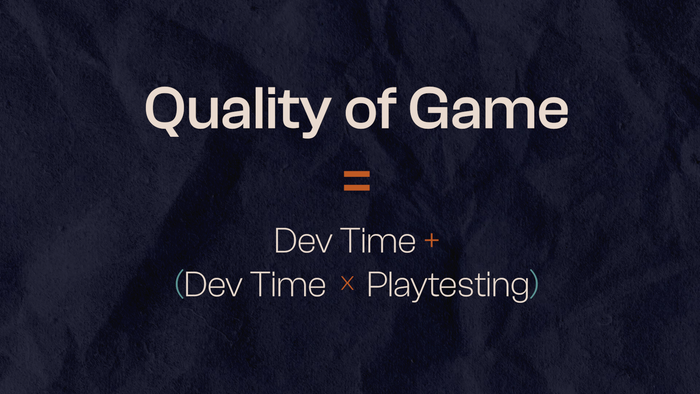
Quality of Game = Dev Time + (Dev Time * Playtesting)
Quality of Game = Dev Time + (Dev Time * Playtesting)
Before we begin:
Playtesting often gets mixed in with Quality Assurance, so I want to point out the distinction.
Quality Assurance testing (or QA), is about Functionality. Finding bugs, typos and other errors.
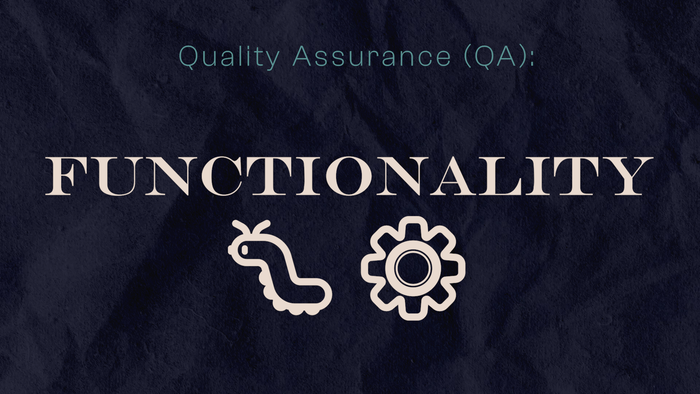
Whereas playtesting is about putting your game in front of fresh players to see where the magic happens. Playtesting is for proving appeal.
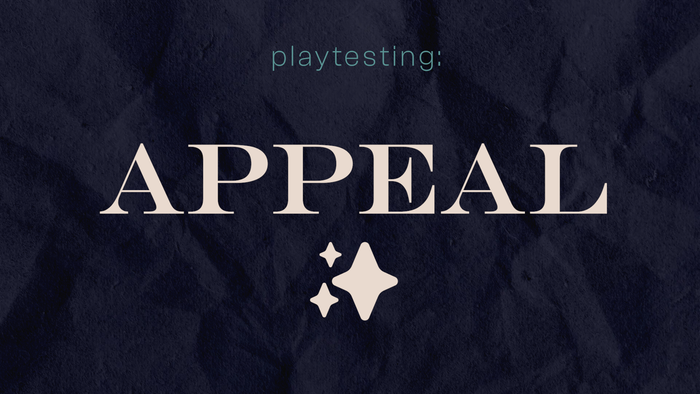
If you don’t playtest, my hope is that the first thing you do after reading is schedule one. And if you do playtest, then I hope this article helps you playtest even harder.
Most indie devs seem to know they should be playtesting, but, whenever I ask if they are, I often hear a lot of excuses - myself included. The excuses usually center around the following sentiment: There’s no time!
But what if I told you that the designers of the most successful games consider playtesting the highest priority in game development?

Part 1: Everybody’s Doin’ It
Part 1: Everybody’s Doin’ It
Mike Ambinder, Valve’s former Principal Research Scientist says "For us, playtesting is the most important part of the game development process. ... it is the dominant factor that shapes our decisions about what to release and when to release it.”

I reached out to him to see if he had more to say on the subject.
Mike Ambinder:
Every game design is an hypothesis, and playtests are experiments.The goal is to get as much information as you can to make the most informed decisions possible about the design of your game.The goal is to make a game that is appealing to the people who play it.Best way to do that is to put the game in front of people who are not you. Then iterate and improve the games as a consequence. The goal is to get it in front of people as quickly as we can and see if we’re on the right track.
Mike emphasizes that playtesting is a scientific tool to assess uncertainty and that the answers lie within your players. He had a lot of other amazing things to say, so we’ll hear more from him later.
I often compare game design to blindly stumbling forward in the dark. In this metaphor, playtesting is like a distant lighting strike, briefly illuminating the landscape, allowing you to check your path and make adjustments. (or reveal you’re about to walk off a cliff)

Playtesting is like checking to make sure you’re not about to walk off a cliff.
Playtesting is like checking to make sure you’re not about to walk off a cliff.
Schell Games has the following guiding principle: “Playtest Constantly. It’s the Only Way to Know.”
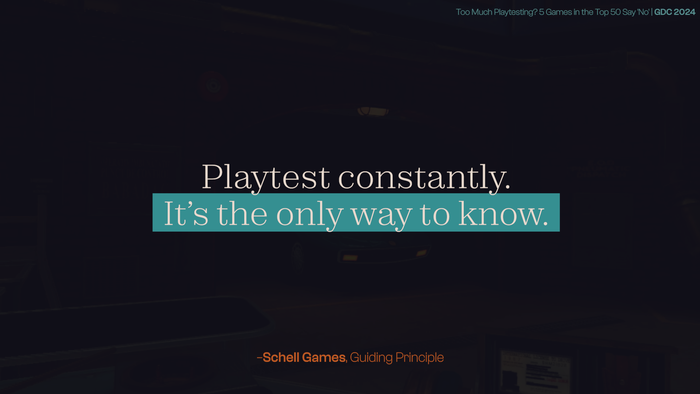
In a 2024 GDC talk, Francisco Souki, the Principal Game Designer of Schell Games credited the success of their games to their rapid player testing workflow. (We’ll come back to their workflow later)
“Playtest Constantly. It’s the Only Way to Know” exemplifies this idea of constantly checking your path in the dark. Playtesting steers your development process towards what players connect with. What the Schell team realizes is that playtesting prevents you from planning too far into the future on just a hunch.
Richard Lemarchand, co-lead of the Uncharted series, says that while his focus in game design today is playtesting, it wasn’t always seen as an invaluable tool.
In an gamesuserresearch.com interview he said, “in the ’90s and even in the early 2000s, playtesting and especially user research, wasn’t very prevalent.”
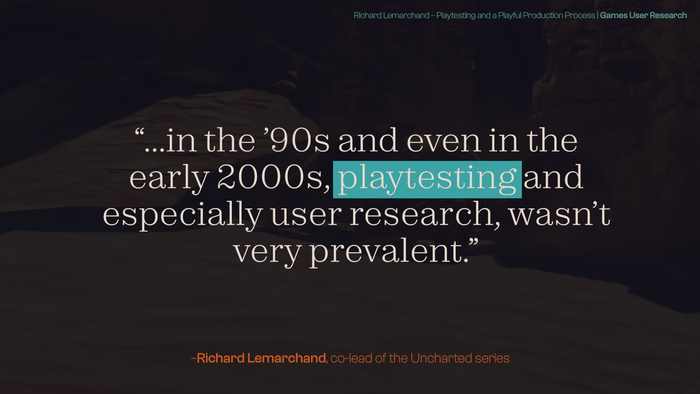
In fact, it wasn’t until he was working for Naughty Dog in the late 2000s that he says the importance of play testing really “clicked” for him.
The struggle to make playtesting a part of the dev process is touched on in the book “The Secret Science of Games”. The author, John Hopson, has been a research lead for Halo, World of Warcraft, Overwatch, Destiny, Fortnite, and more.
In his book, he writes about how during the development of Halo, Bungie had an initial hesitance to bring playtesting into the fold. But as they began to see the positive results, successive titles allowed playtesting to become more and more integrated with the development process.
Knowing it took the industry a couple decades to catch on to playtesting makes me feel a little less dumb for waiting two years to start testing my own game.
I reached out to John to see if he had more insight into why it took the industry so long to embrace playtesting and he pointed to the growth of online feedback post-release.
Before internet reviews, game developers used to ship games and rarely hear from players.
Now, when a game is released, they receive an onslaught of player feedback on the internet.
He believes that today it’s easier to convince game developers to incorporate a more structured version of player feedback earlier in the process to avoid problems with angry players at release.
This may be more of a AAA problem than an indie problem, but if you needed another reason to playtest: just imagine an onslaught of angry reviews of something you could’ve easily avoided by collecting feedback before launch.
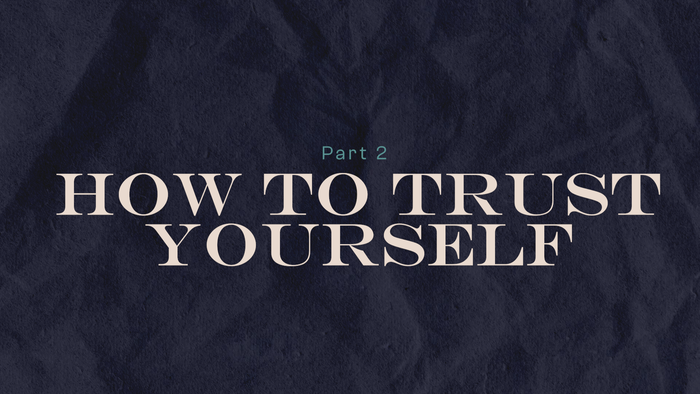
Part 2: How to Trust Yourself
Part 2: How to Trust Yourself
Daniel Kahneman was a nobel prize winner who (despite being a psychologist) became known as the “grandfather of behavioral economics”. If you’ve ever heard of cognitive biases before, he and Amos Traversky were the first to introduce them.
Kahneman says, “Intuition feels just the same when it’s wrong and when it’s right”
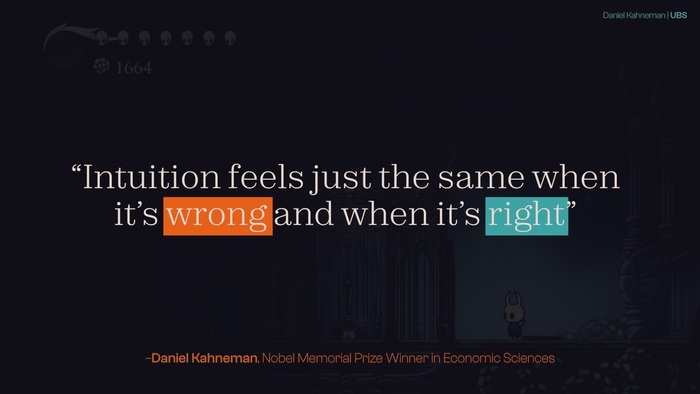
Kahneman writes that academic researchers have repeatedly confirmed that professionals often contradict their own prior judgments when given the same data on different occasions. Kahneman calls this “The Illusion of Skill”
But that doesn’t mean you can’t trust your intuition.It’s not until you are confronted with failure, adapt, and then find what works that you begin to build an intuition you can trust.
Kinda sounds like playtesting, right?
Mike Ambinder:
There are some of the best game designers in the world at Valve. They



































